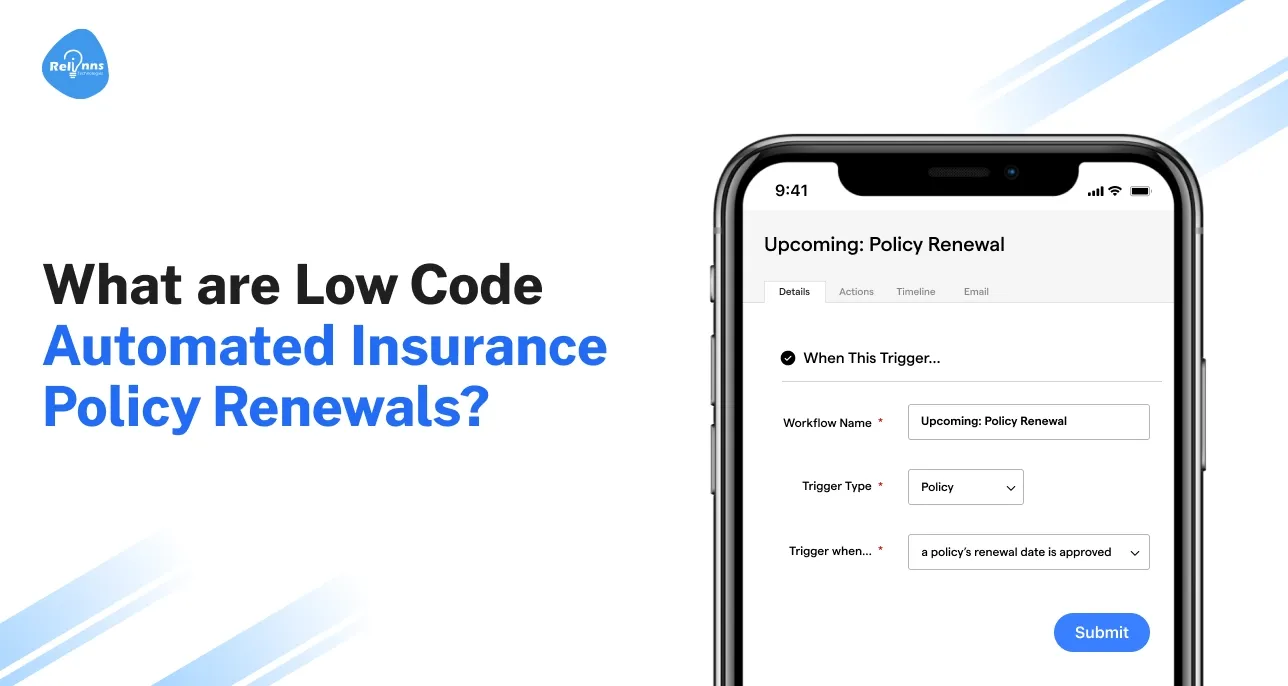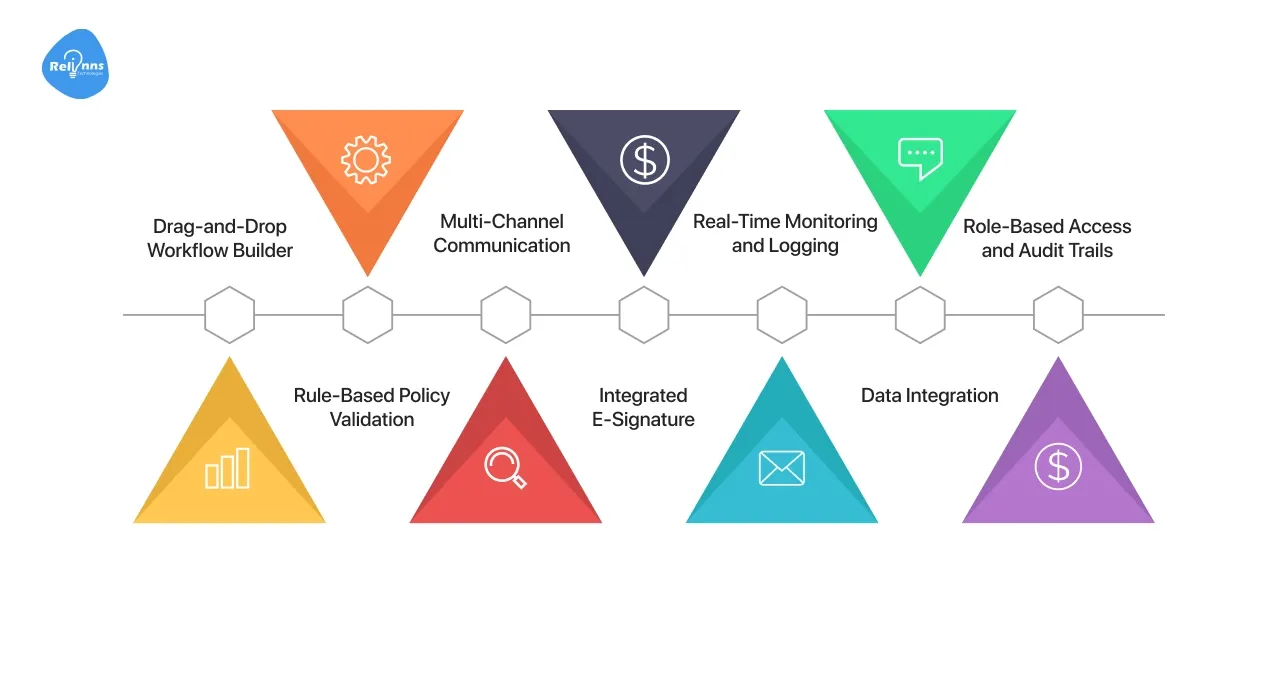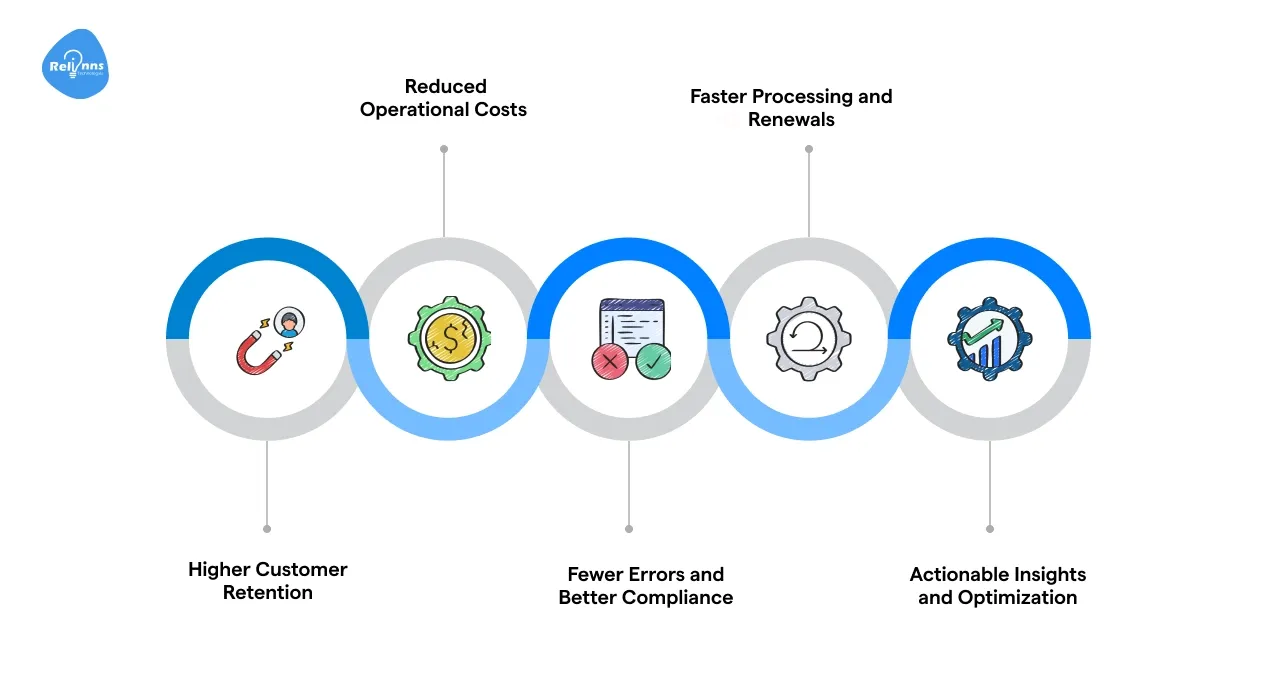What are Low Code Automated Insurance Policy Renewals?
Date
Jul 21, 25
Reading Time
13 Minutes
Category
Low-Code/No-Code Development

Introduction
Renewing insurance policies shouldn’t be a manual mess, but for many insurers, it still is. Agents chase down payments, manually update records, and send follow-ups via email or phone. It’s slow, error-prone, and puts customer retention at risk.
That’s where automated insurance policy renewals come in.
In simple terms, these systems use predefined digital workflows to renew policies with little or no human involvement. Once a customer’s policy is nearing expiry, automated systems trigger notifications, generate updated quotes, and collect payments digitally, streamlining the entire process.
Now, combine that with low-code platforms, and insurers have the power to configure these renewal workflows visually, using drag-and-drop logic. You don’t need months of developer time or manual coding to build or update processes.
This blog will break down what low-code automated insurance policy renewals are, why they matter, the technologies that power them, and how insurers can implement them to boost retention, revenue, and operational agility.
Why Low Code Matters in Insurance Policy Renewals
Today’s insurers face a growing paradox: while digital adoption is rising, the technical teams needed to build those digital systems are stretched thin. And in the high-volume world of policy renewals, delays aren’t just annoying- they’re expensive.
This is where low-code automation platforms shine.
Low-code tools enable insurers to create, update, and deploy automated insurance policy renewals using visual workflows, eliminating the need for custom code.
This empowers product managers, business analysts, and operations leaders to configure logic for email triggers, premium calculations, or policy validation without waiting on developers.

Here’s why this shift matters for insurance teams.
- No developer bottlenecks: Teams can launch and update renewal processes fast, no long IT queues.
- Real-time adaptability: Modify workflows as regulations change or when customer expectations shift.
- Speed to deployment: Insurers can go live with a renewal solution in weeks, not months.
- Improved compliance: Visual logic ensures consistent enforcement of eligibility checks and documentation rules.
- Scalable updates: Insurers can test renewal triggers, add new communication channels, or integrate payment methods without breaking core systems.
With automated policy renewals, time-based workflows ensure every policyholder receives proactive outreach. Whether it’s a renewal quote 30 days before expiry or an SMS reminder 3 days before a lapse, automation ensures follow-through.
Low-code is not just a trend. It’s how smart insurers now close operational gaps while building for long-term scalability. In 2025 and beyond, insurance companies that want to win at retention will need to excel at automation, and low-code is the key to achieving this.
Must-Have Features in Low-Code Renewal Platform
Not all automation platforms are created equal, especially in a complex, compliance-heavy industry like insurance.
When selecting a tool to manage automated insurance policy renewals, insurers must look beyond surface-level functionality and focus on real-world needs, including speed, accuracy, compliance, and customer experience.
A low-code platform purpose-built for automated policy renewals should offer a blend of technical capability and business usability. The goal is to enable quick launch, seamless updates, and secure integrations- without overloading IT.

Here are the essential features to look for-
- Drag-and-Drop Workflow Builder: Build renewal journeys visually—define triggers, business rules, fallback steps, and approval flows without writing code.
- Rule-Based Policy Validation: Automate checks for age, policy type, coverage limits, lapse periods, and underwriting eligibility to reduce rework and rejections.
- Multi-Channel Communication: Trigger SMS, email, or chatbot-based messages to keep policyholders informed and engaged throughout the renewal cycle.
- Integrated E-Signature and Payment Processing: Support seamless online payments through Stripe, Razorpay, etc., and collect digital signatures via tools like DocuSign or Adobe Sign.
- Real-Time Monitoring and Logging: Track every action with detailed logs and dashboards—monitor open rates, quote acceptance, failed payments, and success ratios.
- Data Integration: Connect with CRM, policy administration systems, and billing systems using APIs or RPA to eliminate silos and synchronize updates automatically.
- Role-Based Access and Audit Trails: Ensure only authorized staff can modify workflows. Maintain full compliance by logging every user action and system event.
Key Features-
- Drag-and-drop workflow editor accelerates deployment and reduces coding time.
- Auto-validates renewals against age, plan, and compliance rules.
- Sends omnichannel notifications for better user reach and engagement.
- Supports online payment and e-signature for seamless renewal execution.
- Provide long-term tracking with error logs and an analytics dashboard.
With these features in place, automated insurance policy renewals become not only possible but also repeatable, scalable, and compliant with regulations.
Benefits of Automated Insurance Policy Renewals
Automated insurance policy renewals aren’t just a digital convenience- they’re a strategic advantage. Insurers that embrace renewal automation gain operational speed, increase retention rates, and reduce avoidable revenue loss.
Especially when powered by low-code tools, automated policy renewals can deliver measurable ROI in a short time.

1. Higher Customer Retention
Retention is the lifeblood of insurance profitability. Manual renewals often result in delayed communication or policy lapses.
With automated insurance policy renewals, customers receive timely and personalized renewal messages that ensure they don’t miss coverage deadlines.
This boosts trust, satisfaction, and the likelihood of renewing on time, year after year.
- Sends automated reminders through SMS, email, and chatbot notifications
- Target customers before expiry using policy date-based workflows
- Uses behavioral triggers to send personalized follow-up messages
- Ensures renewals happen even outside business or agent hours
- Reduces churn from missed communication or manual outreach gaps
2. Reduced Operational Costs
Manual processing of renewals is time-intensive and resource-heavy.
From sorting expiring policies to sending reminders and validating payments, the cycle demands significant administrative support.
Automated policy renewals reduce this burden by streamlining every step through software, freeing your team to focus on high-value tasks and reducing unnecessary expenses.
- Automates renewal cycles with zero manual agent or staff input
- Reduces paperwork through system-driven digital policy generation
- Requires fewer support staff during monthly renewal cycles
- Enables rule-based validation to minimize back-and-forth errors
- Updates renewal flows instantly using drag-and-drop configuration tools
3. Fewer Errors and Better Compliance
Insurance renewals must adhere to strict regulatory and underwriting rules.
Human error during renewal can result in invalid policies, coverage gaps, or even legal exposure.
Automated insurance policy renewals apply consistent validation rules every time, ensuring accuracy, maintaining compliance, and creating transparent audit trails for all renewal activity.
- Validates coverage eligibility using pre-set rules and automation logic
- Auto-updates data fields across CRM and policy administration systems
- Applies compliance checks during renewal creation, not post-submission
- Records each policy action in a time-stamped audit history
- Prevents misquotes or lapses with always-on renewal verification
4. Faster Processing and Renewals
Speed is critical in retaining today’s digital-first customers.
Manual renewals can take days. Automated insurance policy renewals execute actions instantly from quote generation to policy issuance—at any time of day.
This responsiveness enables insurers to meet service expectations and process high volumes efficiently, thereby boosting both customer satisfaction and internal efficiency.
- Runs policy renewals automatically, 24/7 with no downtime
- Generates and sends policy documents instantly upon user approval
- Eliminates backlog by routing all actions through instant logic
- Meets SLA and response time standards without manual checks
- Prioritizes urgent renewals using customizable time-based workflows
5. Actionable Insights and Optimization
Automation doesn’t just execute—it learns.
Insurers gain access to powerful renewal data, such as click-through rates, renewal timing, and drop-off reasons. This helps refine strategies, messaging, and channels over time.
Automated insurance policy renewals thus become a continuous loop of performance improvement rather than a static process.
- Tracks renewal completions by channel, time, and behavior triggers.
- Measures that messages convert better across customer segments
- Analyzes where users drop off and optimizes renewal flow
- Monitors exceptions requiring manual approval for internal feedback
- Powers dashboards with metrics for ROI and strategy adjustment
Low-code platforms make these benefits accessible to teams without deep coding expertise, making automated insurance policy renewals a practical and powerful upgrade for insurers of all sizes.
Suggested Reading:
How to Use Low Code for Life Insurance Agency Workflow Software Development
Global Trends and Industry Adoption of Automated Insurance Policy Renewals
Insurance markets worldwide are embracing automation to address evolving customer expectations, regulatory demands, and operational scale.
From the US to MENA and Asia-Pacific, insurers are turning to low-code platforms to streamline automated insurance policy renewals.
As competition intensifies and customer loyalty declines, global carriers view automation as essential to their survival and growth.
1. United States and Canada
In North America, customer demand for digital self-service has exploded. Consumers expect mobile-first renewals, instant quotes, and policy control.
U.S. insurers are now investing in automated policy renewals to meet expectations, reduce the support burden, and increase retention without scaling headcount. AI and chatbots are also seeing widespread deployment in this space.
- 77% of U.S. insurers automate renewal messaging via low-code tools
- Policyholders prefer email and SMS over calls for renewals
- Chatbot reminders reduce support calls by over 40% yearly
- Renewal platforms integrate with Guidewire and Duck Creek seamlessly
- AI predicts non-renewals, enabling proactive retention campaigns
2. United Kingdom and Europe
In the UK and EU, strict regulatory frameworks (like GDPR and IDD) drive the need for traceable, compliant renewal workflows.
Automated insurance policy renewals enable insurers to enforce consistent processes and maintain complete audit trails. Europe also leads in customer-first innovations, such as mobile dashboards and flexible e-policy updates.
- EU insurers use automation to meet IDD and Solvency II
- Renewals must comply with strict consent and data storage laws
- Multilingual automation flows address Europe’s regional diversity
- Low-code renewals connect easily with open insurance APIs
- Dynamic pricing models rely on real-time renewal behavior data
3. Middle East and North Africa (MENA)
MENA insurers are scaling fast. UAE, Saudi Arabia, and Egypt have seen significant growth in health and motor insurance mandates.
Automated policy renewals play a crucial role in reducing administrative burdens and enabling mass-market scalability. WhatsApp bots and local-language flows are in high demand here.
- The MENA region saw 21% insurance growth in 2024 (MEIR)
- Arabic-language bots automate medical and auto policy renewals
- WhatsApp is the dominant renewal communication channel regionally
- Intelligent automation reduces back-office renewal staffing needs by 60%
- Mandatory renewals require zero-lapse execution at the national scale
4. Asia-Pacific (India, China, SEA)
The Asia-Pacific region is the fastest-growing insurance market globally. With mobile-first customer bases, low-code automation is crucial for meeting diverse user needs.
Policy renewals are delivered through SMS, apps, or in-app prompts. Automated insurance policy renewals here focus on scale, multilingual support, and integration with agent-assisted platforms.
- APAC to account for 42% of global premiums by 2029
- Renewals supported via regional apps like Paytm, WeChat, Grab
- Hybrid models mix chatbot and agent-assisted renewals
- Low-code tools support multilingual policy documents and flows
- Embedded insurance uses renewal automation for travel and fintech apps
5. Universal Trends Across All Markets
Across every market, one message is clear: renewals must be fast, error-free, and digital.
Insurers using automated insurance policy renewals report fewer lapses, higher lifetime value, and less support overhead. Whether for compliance, customer loyalty, or cost control, automation is the new global standard.
- 70% of insurers globally use or plan to use low-code renewal systems
- Digital renewal experience drives 20% increase in Net Promoter Score
- Automation improves renewal cycle completion rate by up to 50%
- Low-code platforms deliver faster go-lives in every region
- Policyholder satisfaction improves with consistent, timely renewals every cycle
How to Implement Automated Insurance Policy Renewals (Step-by-Step)
Adopting automated insurance policy renewals doesn’t require a massive IT overhaul. With a low-code platform, insurers can build scalable, regulation-ready workflows in weeks.
The key is starting with a clear roadmap—one that identifies your goals, integrates your systems, and strikes a balance between automation and human oversight. Here's how to do it right.

Step 1: Audit Your Current Renewal Process
Before automating anything, map your current workflows to ensure a smooth transition. Understand where delays, errors, or drop-offs occur.
Clarify which tasks are rule-based and which need human approval. This process mapping forms the automation blueprint, especially when transferring logic into a low-code platform like Joget.
- Identify gaps where renewals fail, are delayed, or require escalation
- Document all communication triggers and their current delivery methods
- List key policy rules applied manually during renewals
- Spot dependencies on spreadsheets, emails, or legacy policy software
- Clarify which renewals are eligible for full hands-off automation
Suggested Reading:
Get Health Insurance Agency Workflow Software with Joget
Step 2: Choose the Right Low-Code Platform
Select a platform tailored for insurance—one that supports integrations, compliance, and visual workflow building.
Joget (powered by Relinns) is a leading option, enabling insurers to configure robust renewal systems fast, without relying on developers or rewriting their tech stack.
- Pick platforms offering drag-and-drop policy workflow builders
- Ensure support for APIs to connect policy admin and CRM
- Confirm it handles multilingual communication and local compliance rules
- Check platform uptime, hosting options, and scalability across teams
- Verify available insurance-specific templates or modules for renewals
Step 3: Design the Renewal Workflow Visually
Using your chosen platform, translate the mapped logic into a visual representation of the process. Define every trigger, decision point, alert, and rule.
Include conditional logic, such as lapse time, premium thresholds, discounts, and document requirements. Start small—then iterate.
- Define trigger rules like “30 days before expiration, send alert.”
- Add fallback steps in case payment fails or the user declines
- Include conditional logic like coverage type or customer risk rating
- Route exceptions to underwriters or agents via custom flows
- Test for edge cases like policy reinstatement or partial payment
Step 4: Integrate Payment, CRM, and Signature Tools
For a seamless experience, your automation must communicate with other systems, including CRM, billing, policy core, and e-signature.
Build APIs, use ready connectors, or implement RPA to bridge legacy gaps. This ensures that renewal data remains accurate and complete across all systems.
- Connect policy data using REST APIs or secure RPA bots
- Push updates to CRM instantly after renewal confirmation
- Trigger e-signature requests via Adobe Sign or DocuSign
- Sync premium status with payment gateways like Stripe or Razorpay
- Auto-update billing records after confirmation and receipt generation
Step 5: Monitor, Optimize, and Scale
Launch the workflow in phases, and monitor performance. Use dashboards to identify drop-offs, delays, or manual escalations.
Improve continuously—test message variants, retry logic, or new channels. Once stable, scale across policy types and regions.
- Track open, click, and completion rates for renewals
- A/B test subject lines, SMS templates, or time-of-day alerts
- Use analytics to spot slow approval segments or missed renewals
- Add support for additional languages or policy categories
- Scale from pilots to global deployment in phases
Why Automated Insurance Policy Renewals Are the Future of Retention
The future of renewals is automated, scalable, and customer-centric. In a competitive insurance market, relying on manual renewals is no longer sustainable. Policyholders expect proactive outreach, instant confirmations, and a seamless digital experience.
By implementing automated insurance policy renewals through a low-code platform, insurers can deliver faster service, reduce costs, and retain more customers with less friction.
Automation minimizes delays, errors, and regulatory risk while giving teams complete control over workflow updates, exceptions, and performance.
Relinns Technologies offers low-code no-code app development services to make all of this possible for you.
As a trusted leader in low-code insurance automation, Relinns helps insurers deploy fully integrated renewal systems using the Joget platform.
Their solutions are fast to launch, easy to adapt, and designed with insurance compliance and scalability in mind.
Why Insurers Trust Relinns
- 90% workflows are built with zero code by business teams
- 40% faster deployment than traditional insurance workflow projects
- 75% fewer manual errors using real-time renewal validation logic
- Compatible with 95% of legacy CRM and policy systems
- Drag-and-drop configuration reduces IT dependency by over 60%
Contact Relinns for smarter, smoother renewals—so you can focus on growth.
Frequently Asked Questions (FAQs)
1. What is the difference between automated insurance policy renewals and robotic process automation (RPA)?
While RPA mimics manual clicks, automated insurance policy renewals use rules-based workflows in low-code platforms to initiate, validate, and complete renewals without replicating human actions.
2. Can automated policy renewals work for different policy types like life, auto, and health insurance?
Yes. Low-code platforms enable the customization of automated policy renewals for motor, life, health, or commercial lines, utilizing product-specific triggers, logic, and compliance validations.
3. Are automated insurance policy renewals secure and regulation-compliant?
Modern platforms support encryption, role-based access, and full audit trails. This ensures that automated insurance policy renewals comply with laws such as HIPAA, GDPR, and IRDAI regulations, depending on the region.
4. How do insurers track the success of automated policy renewals?
They utilize built-in dashboards that display renewal rates, drop-offs, open rates, and SLA compliance. These insights help insurers continuously improve their automated policy renewals performance and outreach strategy.
5. What happens if a customer wants to modify their policy during auto-renewal?
Smart automated insurance policy renewals allow customers to adjust coverage, update documents, or pause renewals through self-service portals or chatbot-driven conversations—without disrupting the entire renewal flow.
6. Is it possible to integrate automated insurance policy renewals with legacy core systems?
Yes. Most low-code platforms offer prebuilt API connectors or RPA bridges to seamlessly sync automated insurance policy renewals with older CRM, billing, or policy administration systems.


